Dogs
Hi Julie,
The toddler is currently learning (slowly) that the world is not 100% about the toddler. This involves me frequently coaching the toddler’s interactions with other people and children (“yes it’s very sweet that you love your friend and that you’re giving them a big hug, but now you’ve actually crash-tackled them to the floor and they’re crying, it might be time to give them space”) and more recently in a similar way with the dogs.
Why are dogs good for children? The biophilia hypothesis suggests that people are instinctively attracted to animals and nature. It proposes that our relationship with them may contribute on an intimate biological level to our sense of fulfilment and identity. In our current busy lifestyles, often lived in industrialised city environments removed from ‘nature’ in its purest form, dogs and other companion animals offer opportunities for these ‘biophilic’ relationships.
The biophilia hypothesis suggests that people are instinctively attracted to animals and nature. It proposes that our relationship with them may contribute on an intimate biological level to our sense of fulfilment and identity. In our current busy lifestyles, often lived in industrialised city environments removed from ‘nature’ in its purest form, dogs and other companion animals offer opportunities for these ‘biophilic’ relationships.
These nurturing relationships with animals are considered particularly important during early and middle childhood. Some research suggests that humans have a higher degree of attachment to dogs than we do to other companion animals; however, this may be a flaw in the way such studies have assessed attachment.
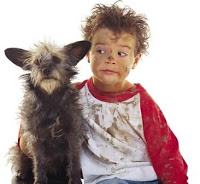 Dogs may promote respect and compassion for animals and nature by offering a child valuable opportunity to experience and learn about animals and the ‘facts of life’. Dogs can assist children to learn about responsibility. They can encourage trust, self-belief as well as caring attitudes and behaviour. They may promote exercise and healthy development, offer social support and provide companionship, security, comfort. Dogs can be an important source of fun and have demonstrated they can act as an outlet for childhood affection.
Dogs may promote respect and compassion for animals and nature by offering a child valuable opportunity to experience and learn about animals and the ‘facts of life’. Dogs can assist children to learn about responsibility. They can encourage trust, self-belief as well as caring attitudes and behaviour. They may promote exercise and healthy development, offer social support and provide companionship, security, comfort. Dogs can be an important source of fun and have demonstrated they can act as an outlet for childhood affection.
Research has shown that regular contact with two or more dogs in the first year of life is correlated with a reduced incidence of childhood allergies and asthma. The presence of a dog in a learning environment (such as a classroom) has been shown to contribute to children’s motivation and can speed task completion without compromising accuracy. Dogs in this context also aid emotional stability, improve children’s attitudes towards school and aid in the learning of respect, empathy and responsibility.
Serpell J. (1999). Animals in Children's Lives, Society & Animals, 7 (2) 87-94. DOI: 10.1163/156853099X00013
O'Haire M. (2010). Companion animals and human health: Benefits, challenges, and the road ahead, Journal of Veterinary Behavior: Clinical Applications and Research, 5 (5) 226-234. DOI: 10.1016/j.jveb.2010.02.002
Melson G.F. Child Development and the Human-Companion Animal Bond, American Behavioral Scientist, 47 (1) 31-39. DOI: 10.1177/0002764203255210
Blue G.F. (1986). The Value of Pets in Children's Lives, Childhood Education, 63 (2) 85-90. DOI: 10.1080/00094056.1986.10521747
Zasloff R.L. (1996). Measuring attachment to companion animals: a dog is not a cat is not a bird, Applied Animal Behaviour Science, 47 (1-2) 43-48. DOI: 10.1016/0168-1591(95)01009-2
Holscher B., Frye C., Wichmann H.E. & Heinrich J. (2002). Exposure to pets and allergies in children, Pediatric Allergy and Immunology, 13 (5) 334-341. DOI: 10.1034/j.1399-3038.2002.02063.x
Anderson K.L. & Olson M.R. (2006). The value of a dog in a classroom of children with severe emotional disorders, Anthrozoos: A Multidisciplinary Journal of The Interactions of People & Animals, 19 (1) 35-49. DOI: 10.2752/089279306785593919
Gee N.R., Harris S.L. & Johnson K.L. (2007). The Role of Therapy Dogs in Speed and Accuracy to Complete Motor Skills Tasks for Preschool Children, Anthrozoos: A Multidisciplinary Journal of The Interactions of People & Animals, 20 (4) 375-386. DOI: 10.2752/089279307X245509
- Attachment: Measuring Our (varying) Relationships With Dogs.
Hi Julie, Right off the bat I need to say YES YES YES! Your last post about aggression and what we can learn from and about it WITHOUT the need to experience it was spot on. Are you THIS attached to your dog? (source)You’re also right that...
- The Science Surrounding Children & Dogs: Part 3 (the Ugly)
Cute or feeding an unrealistic fantasy? (source)Hey Julie, You raise such an important point! In the same way that popular culture can influence our perceptions and interpretations of ‘cute’ in domains like body image and kawaii, photos of...
- Mixing Kids & Dogs: A 'how To' Resource List
Hi Mia, Friends for life is a wonderful way to describe growing from childhood to adulthood with a dog. For me, Arf was always around till a living, breathing dog came into my life, and you clearly thought dogs were the bomb from an early age! ...
- Video Special: Cutest Thing Ever? Paws On The Face!
I'll start with some eye candy Hi Mia, "What do you think is the most common role of dogs these days?" As I read that in your last post, I blurted out, "companionship" (the guy sitting next...
- How Pets Help Children With Autism
By Langley Cornwell Most people who share their life with a pet enjoy talking about how strong their connection is with their animal. They like to discuss how much they delight in spending time with their pet. They share stories that illustrate how well...
Dogs
The Science Surrounding Children & Dogs: Part 1 (The Good)
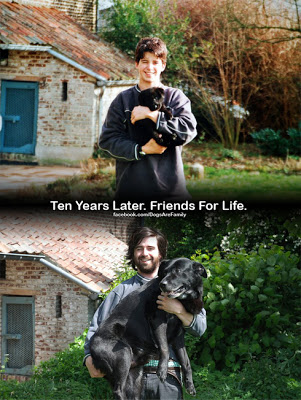 |
| (source) |
Oh my, but KAWAII is cute! I guess that’s kind of the point? I love that cute is good for us.
All this talk of cute, a website and some observations at home got me thinking this week.
I recently saw this image posted on Facebook and I don’t mind admitting that it tugged at my emotions.
Around the same day, I was watching my two year old toddler (an unpublished and independent kawaii survey reports the toddler is somewhat cute) interacting with my dogs (they are cute, no survey required).
Around the same day, I was watching my two year old toddler (an unpublished and independent kawaii survey reports the toddler is somewhat cute) interacting with my dogs (they are cute, no survey required).
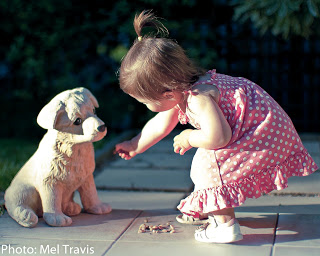 |
| (source) |
The toddler is currently learning (slowly) that the world is not 100% about the toddler. This involves me frequently coaching the toddler’s interactions with other people and children (“yes it’s very sweet that you love your friend and that you’re giving them a big hug, but now you’ve actually crash-tackled them to the floor and they’re crying, it might be time to give them space”) and more recently in a similar way with the dogs.
These home observations and website images got me thinking about how important my pets, and in particular, my dogs, were to me while growing up.
It got me wondering - why do so many of us have enduring psychological attachment to our childhood dogs?
And do our childhood experiences stay with us as firmly held attitudes into adulthood?
I plan to spend my next posts looking at some of the science surrounding children and dogs: the good, the bad and the ugly.
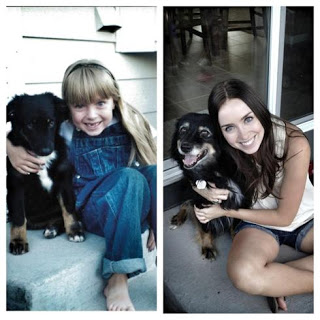 |
| (source) |
And do our childhood experiences stay with us as firmly held attitudes into adulthood?
I plan to spend my next posts looking at some of the science surrounding children and dogs: the good, the bad and the ugly.
Why are dogs good for children?
 The biophilia hypothesis suggests that people are instinctively attracted to animals and nature. It proposes that our relationship with them may contribute on an intimate biological level to our sense of fulfilment and identity. In our current busy lifestyles, often lived in industrialised city environments removed from ‘nature’ in its purest form, dogs and other companion animals offer opportunities for these ‘biophilic’ relationships.
The biophilia hypothesis suggests that people are instinctively attracted to animals and nature. It proposes that our relationship with them may contribute on an intimate biological level to our sense of fulfilment and identity. In our current busy lifestyles, often lived in industrialised city environments removed from ‘nature’ in its purest form, dogs and other companion animals offer opportunities for these ‘biophilic’ relationships. These nurturing relationships with animals are considered particularly important during early and middle childhood. Some research suggests that humans have a higher degree of attachment to dogs than we do to other companion animals; however, this may be a flaw in the way such studies have assessed attachment.

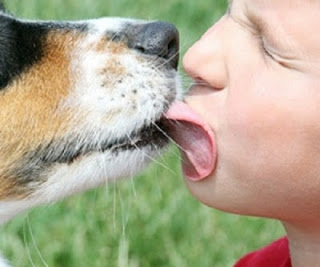 |
| (source) |
So it seems like there’s a lot to like about fostering a positive relationship between children and dogs. But what happens to children when such an important relationship ends? And do our childhood experiences stay with us into adulthood?
Don't worry - I’ll be sure tell you more about that next time!
Don't worry - I’ll be sure tell you more about that next time!
Mia
p.s. Don't forget to head over to our facebook page to keep track of the 'childhood dog' photo challenge!
p.s. Don't forget to head over to our facebook page to keep track of the 'childhood dog' photo challenge!
Further reading:
O'Haire M. (2010). Companion animals and human health: Benefits, challenges, and the road ahead, Journal of Veterinary Behavior: Clinical Applications and Research, 5 (5) 226-234. DOI: 10.1016/j.jveb.2010.02.002
Melson G.F. Child Development and the Human-Companion Animal Bond, American Behavioral Scientist, 47 (1) 31-39. DOI: 10.1177/0002764203255210
Blue G.F. (1986). The Value of Pets in Children's Lives, Childhood Education, 63 (2) 85-90. DOI: 10.1080/00094056.1986.10521747
Zasloff R.L. (1996). Measuring attachment to companion animals: a dog is not a cat is not a bird, Applied Animal Behaviour Science, 47 (1-2) 43-48. DOI: 10.1016/0168-1591(95)01009-2
Holscher B., Frye C., Wichmann H.E. & Heinrich J. (2002). Exposure to pets and allergies in children, Pediatric Allergy and Immunology, 13 (5) 334-341. DOI: 10.1034/j.1399-3038.2002.02063.x
Anderson K.L. & Olson M.R. (2006). The value of a dog in a classroom of children with severe emotional disorders, Anthrozoos: A Multidisciplinary Journal of The Interactions of People & Animals, 19 (1) 35-49. DOI: 10.2752/089279306785593919
Gee N.R., Harris S.L. & Johnson K.L. (2007). The Role of Therapy Dogs in Speed and Accuracy to Complete Motor Skills Tasks for Preschool Children, Anthrozoos: A Multidisciplinary Journal of The Interactions of People & Animals, 20 (4) 375-386. DOI: 10.2752/089279307X245509
© Mia Cobb 2012
- Attachment: Measuring Our (varying) Relationships With Dogs.
Hi Julie, Right off the bat I need to say YES YES YES! Your last post about aggression and what we can learn from and about it WITHOUT the need to experience it was spot on. Are you THIS attached to your dog? (source)You’re also right that...
- The Science Surrounding Children & Dogs: Part 3 (the Ugly)
Cute or feeding an unrealistic fantasy? (source)Hey Julie, You raise such an important point! In the same way that popular culture can influence our perceptions and interpretations of ‘cute’ in domains like body image and kawaii, photos of...
- Mixing Kids & Dogs: A 'how To' Resource List
Hi Mia, Friends for life is a wonderful way to describe growing from childhood to adulthood with a dog. For me, Arf was always around till a living, breathing dog came into my life, and you clearly thought dogs were the bomb from an early age! ...
- Video Special: Cutest Thing Ever? Paws On The Face!
I'll start with some eye candy Hi Mia, "What do you think is the most common role of dogs these days?" As I read that in your last post, I blurted out, "companionship" (the guy sitting next...
- How Pets Help Children With Autism
By Langley Cornwell Most people who share their life with a pet enjoy talking about how strong their connection is with their animal. They like to discuss how much they delight in spending time with their pet. They share stories that illustrate how well...
